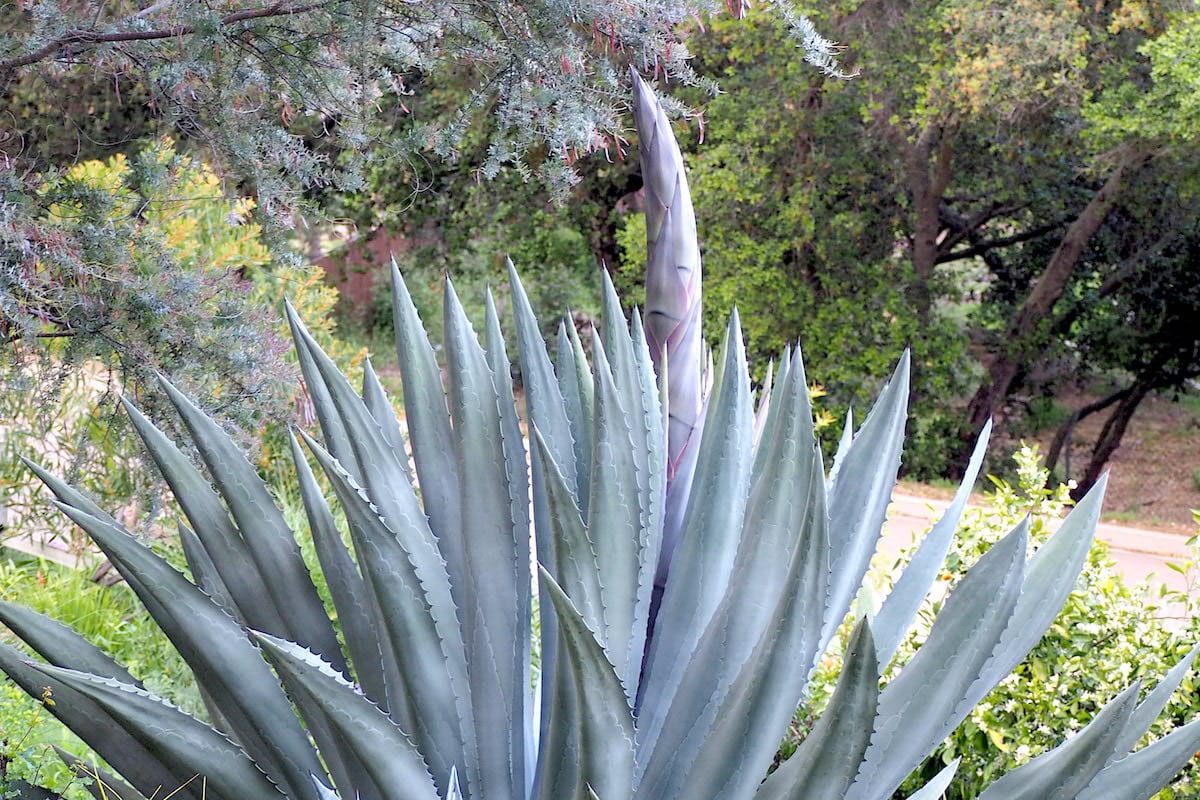
Big Blue’s Life and Demise
The largest succulent ever to grace my half-acre garden was an Agave americana we called “Big Blue.” With six-foot leaves lined with sharp teeth, it looked capable of eating guests who shot selfies with it. Agave americana is commonly called “century plant” because it seems to take forever to flower and die, but Big Blue’s lifespan was only 20 years.

Big Blue at maturity, 2017
Big Blue and I didn’t always get along. It was armed and dangerous, and on occasion snagged my skin and drew blood. This was usually my fault. I liked to lean in and take photos of its bud imprints—scalloped lines caused by leaves that had pressed against each other before they unfurled.
It also tried to take over the garden, producing pups (clones) from its roots. These popped up in all directions, including uphill. This tendency for century plants to reproduce like feral dogs was probably why my neighbors put it out in the trash in the first place. But when I noticed the 2-foot pup, I knew it would look good in a pot, its leaves contrasting with terra-cotta orange.

Big Blue in a terra-cotta pot, 2003
That was seven years before the publication of my first book about succulents, and I had much to learn about agaves. I didn’t think the pup would live because it had been severed at ground level. But after a few months, it plumped and thrived. I kept it in the pot—where it stayed small—and a few years later planted it in the garden.
Big Blue grew ever larger as other ornamentals came and went. A Bailey’s acacia planted near it in 2007 became a 20-foot tree. Every spring, while hosing fallen acacia flowers from the agave’s center, I admired how its guttered leaves funneled water to the roots.
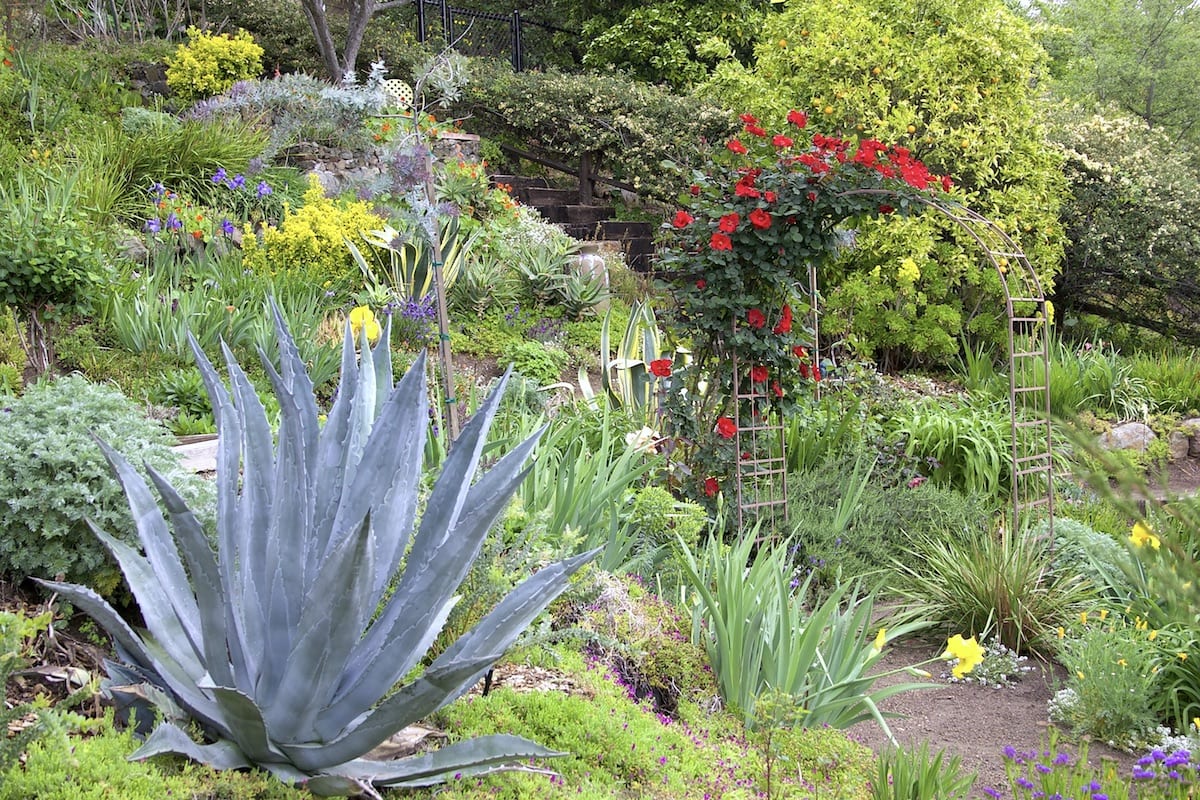
Big Blue commands the garden, April 2007
Agave americana loves irrigation but doesn’t need it, so early-on I capped nearby risers. Peevishly, Big Blue broke a pipe that, located beneath barbed leaves, was impossible to repair. (I should have seen that coming.) After shutting down the line, I spent countless summer afternoons hose-watering.
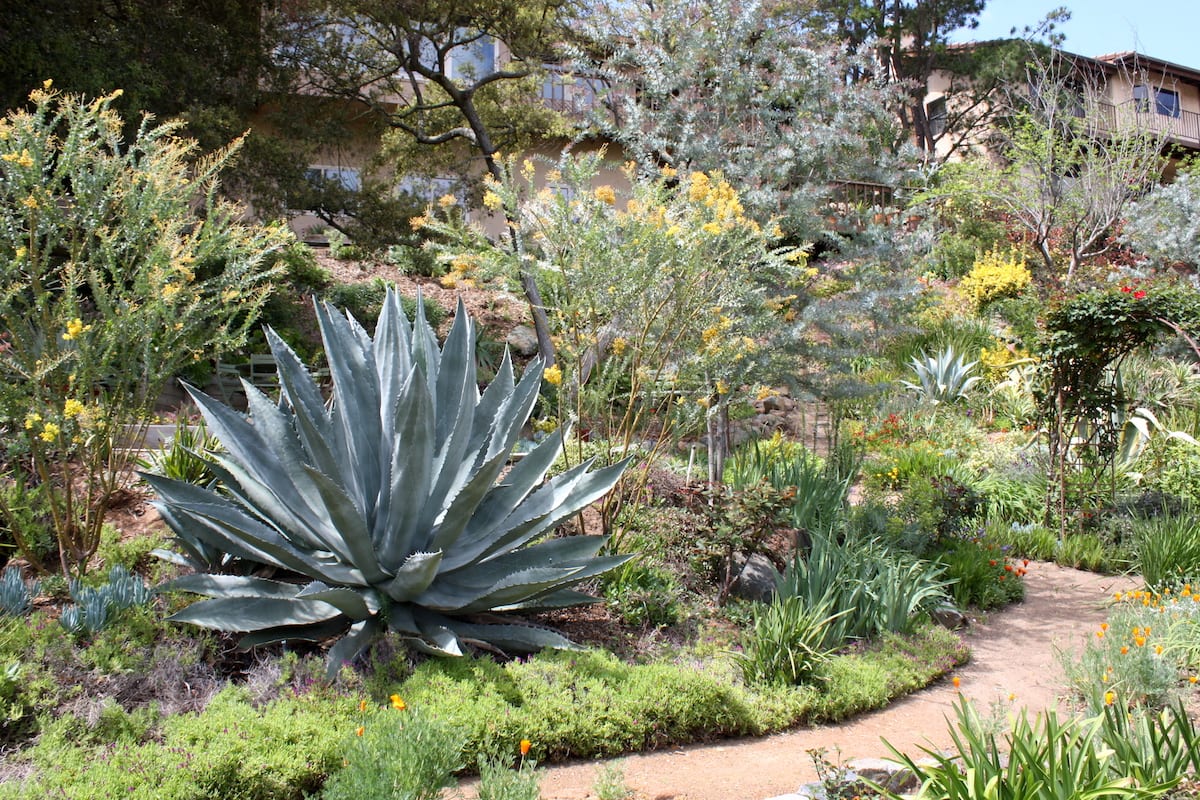
Big Blue in 2010. It’s about half its eventual size.
A landscape designer friend said, “You know, Debra, that americana is going to grow into the pathway.” That seemed unlikely—it was five feet away. I replied, “Then I’ll just move the pathway.” And six years later, I did.
We wore protective glasses when digging-up pups. I gave small century plants to whomever would take them. But because they came with cautions, most went without adoption and languished in 1-gallon nursery pots. Leaves shriveled, then swelled during winter rains. Some of the little rascals rooted through holes in their pots.
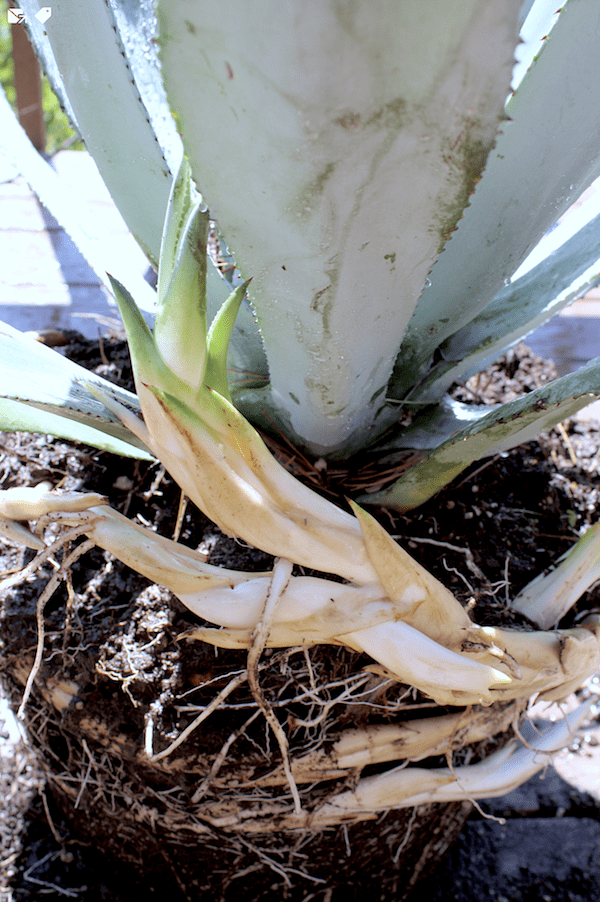
In 2011, Big Blue’s pups had become large and tricky to remove.
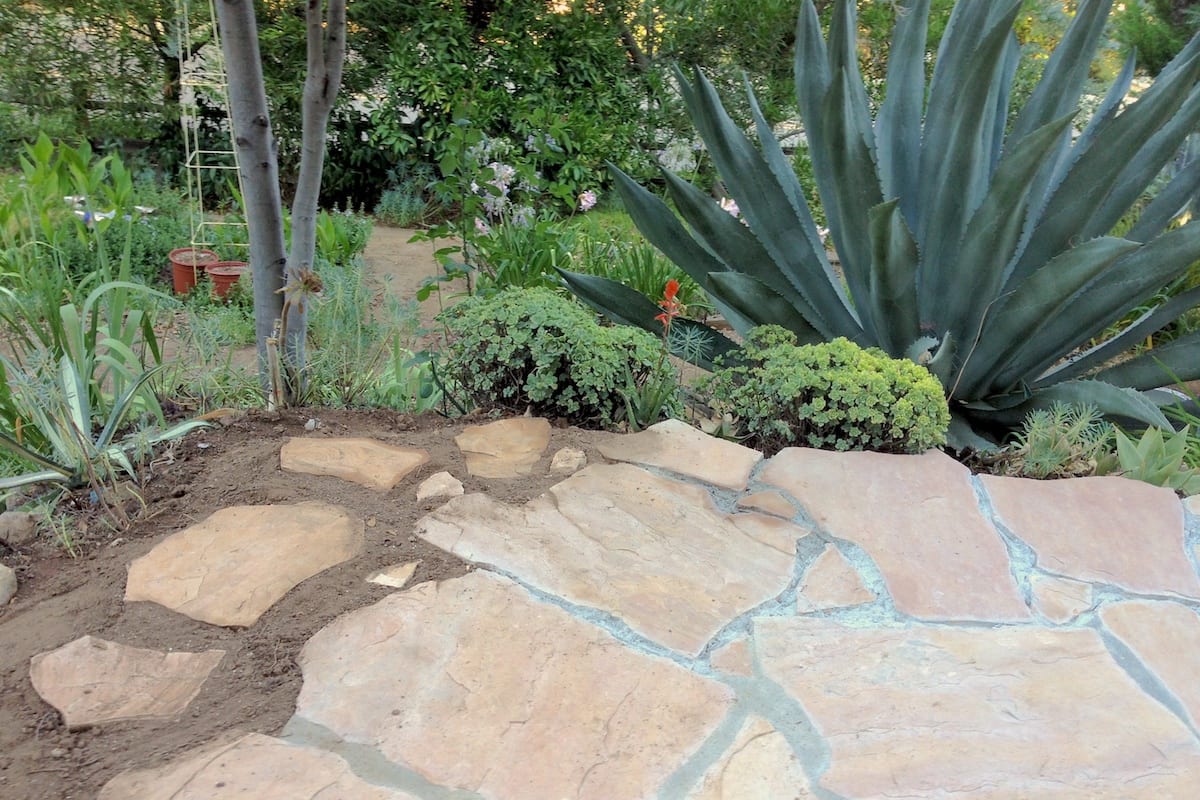
In 2016, its lovely fan of azure leaves framed a new flagstone patio.
Big Blue and I made a YouTube video: “What You MUST know about Century Plants.” In it I explain “the pupping thing” and the mistake of not knowing how big an agave will get before planting it.

Midsummer 2018: Big Blue’s bloom stalk added a temporary tree to the garden.
In February, 2018, Big Blue at last attained the sugar content needed for flowering—a grand achievement that produced masses of flowers followed by seed pods. That summer, the agave’s 30-foot flower spike hummed with pollinators.
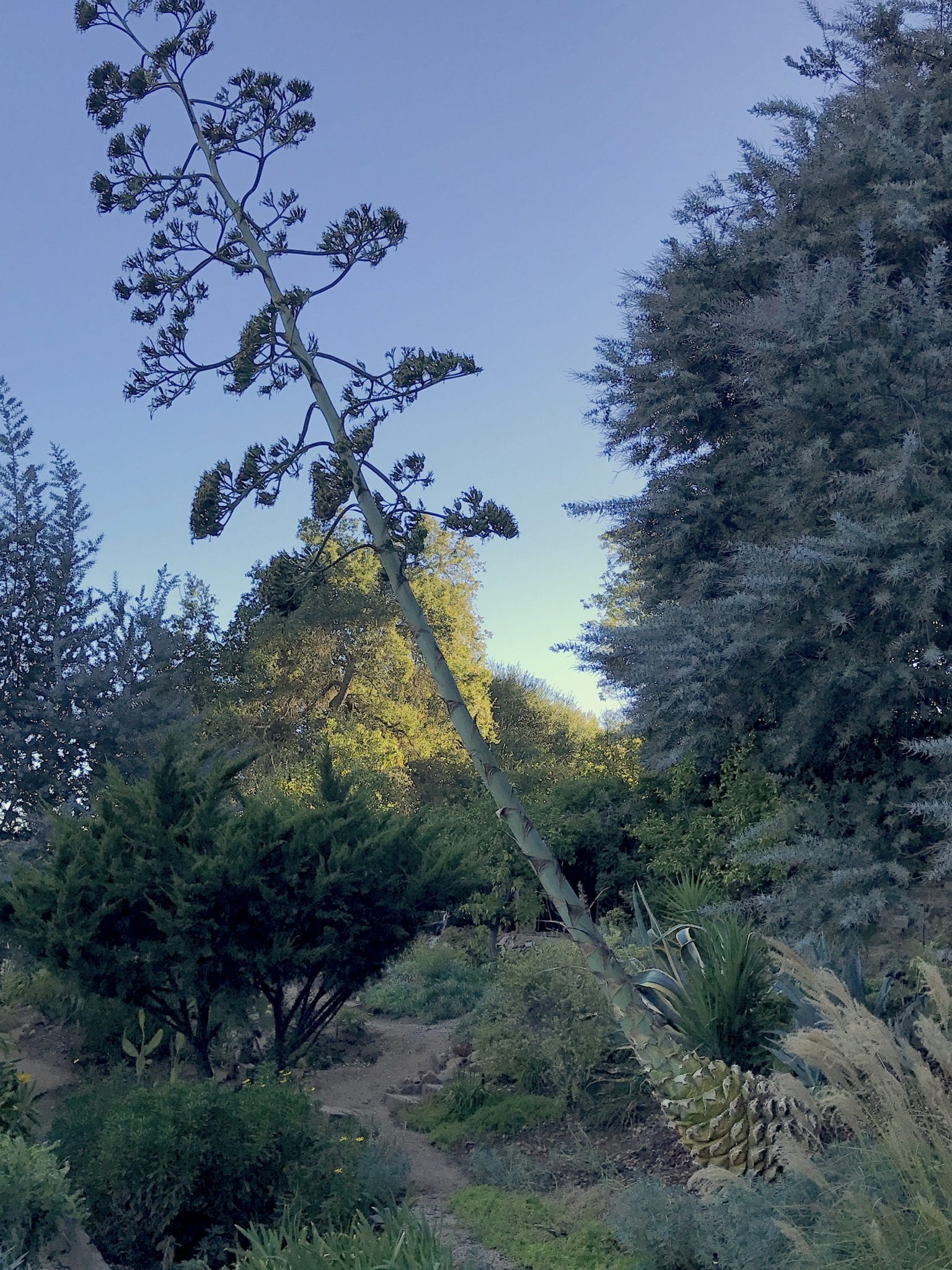
By autumn 2018, seed pods replaced flowers.
Keeping what remained of Big Blue wasn’t optional; its sailboat-mast spike was leaning at a 45-degree angle toward the street. I videoed the agave’s removal that October.
A few years earlier, knowing Big Blue’s demise was inevitable, I decided to keep a well-positioned offset. That pick-of-the-litter is maybe a fourth of its eventual size. I don’t get sentimental about succulents, but I am glad to have Big Blue Two…although (sigh) it’s started pupping.
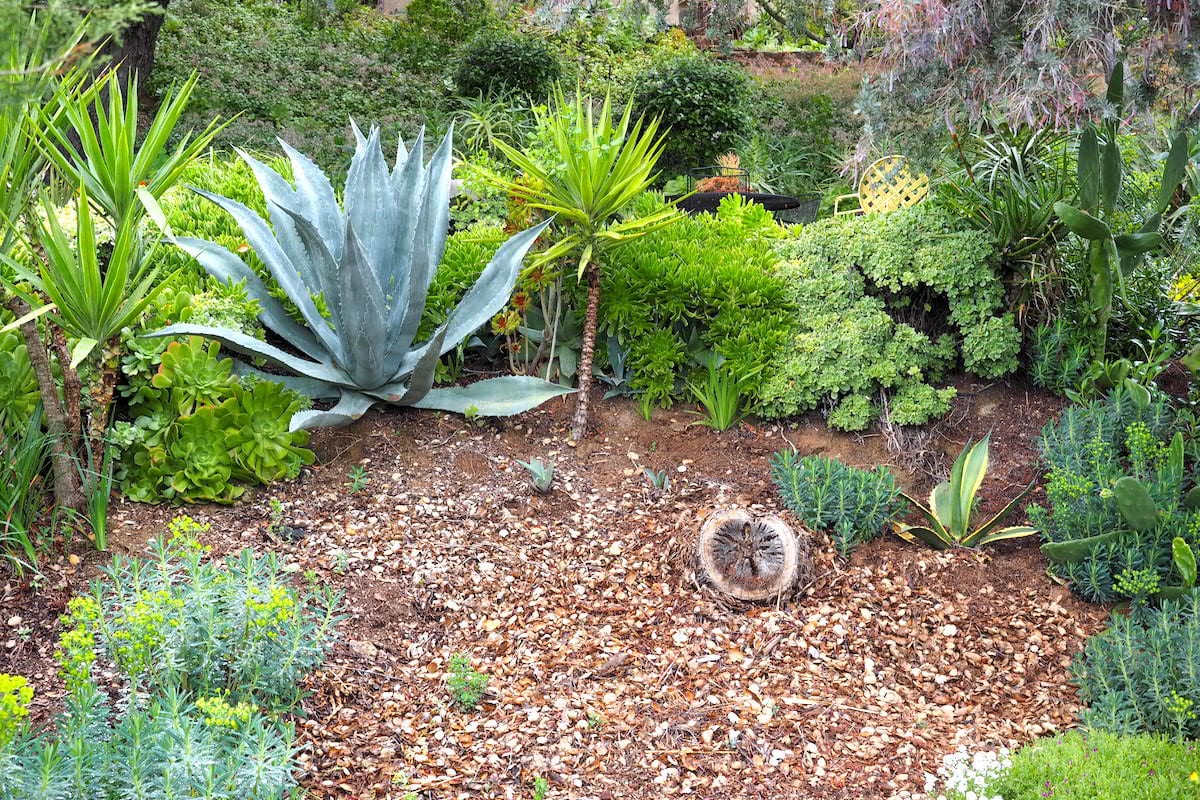
Spring, 2019: A stump is all that’s left of Big Blue. Its clonal replacement is at left.
See Big Blue’s chain-saw exit on my YouTube channel: “Agave americana Bloom and Removal” (4:44). Also:“What You MUST know about Century Plants” (2:50).
Related info on this site:
Agave Dermatitis: How harmful is agave sap? Are you susceptible?
You’re already wary of poison oak, cactus glochids and the milky sap of euphorbias. Add agave sap to the list. In susceptible individuals, it causes the skin condition “agave dermatitis.”
Your Agave’s Blooming–Now What?
Your agave is blooming! Now what? In my new video, Q&A and photo gallery you’ll find expert advice, agave IDs and how to start the plants from seeds and bulbils.
Want to Make Tequila or Mezcal from Your Agaves?
As with most vegetables, roasting an agave’s heart enhances flavor and sweetness. Cottage distilleries in Mexico roast piñas in pits dug into the ground, sort of like a luau.


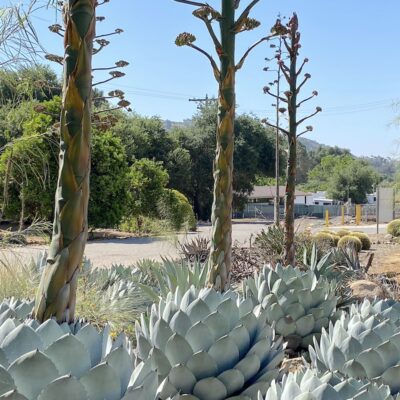

We will miss you big blue!
What a lovely “bio-graphy” and tribute to your foundling pup. Well deserved, too, after 20 years. Thank you for the post and the corresponding videos. I enjoyed them.
Thank you, Jeremy! I’m so glad you enjoyed them! Debra
Very few species of Agave can be “chopped up” without potential injury to the person doing the chopping (or chainsawing). When most members of the genus flower, all of the chemicals (juices produced by the flowering [dying] process) become concentrated in the core and in the bases of the leaves; ergo, the beginnings of tequila (just five species are used for that). Cutting into this tissue releases both liquid and gaseous chemicals that are quite dangerous to humans. If the person doing the cutting passes out due to the fumes, and falls into the plant, death can actually occur due to the person breathing in concentrated fumes… and little to no oxygen. I don’t think much has been written on this yet, but it’s factual. Again, as with most things that I reveal, I have personally witnessed, at least partially, the effects of the stated scenario. No, I didn’t die, but I did manage to get extremely nauseated and came close to passing out. The fumes are overwhelming on many species and I highly recommend either waiting until the plant has dried up or digging it out by the roots while in one piece. They are also much safer to chop up prior to the beginning of the flowering process.
All the best,
Duke
Hi Duke — Your personal experience with such matters is valuable and insightful. Is Agave americana one of those that releases chemicals you’d consider “quite dangerous?” I appreciate your advice that people either remove the plant before it blooms, or wait until the plant has dried up. Previously with blooming agaves, I removed the stalk but not the core until it dried. This was not for the reasons you state but rather when dry it’s lighter in weight. NOTE TO READERS: Duke Benadom is a succulent book author, expert and long-time member of the Los Angeles Cactus & Succulent Society. I recommend his comment on treating Aloe mite, as well. — Debra
Hi Debra! Thank you for such great information on agave Americana. I recently became a homeowner and have inherited two agave Americanas as well as a lovely succulent garden planted by the previous owner (I’m now the proud owner of two of your gardening books). One agave is over 5 feet high and 8 feet wide, the other about 3 1/2ft high and 7 feet wide. They were both planted 8 years ago with one more mature than the other at the time (not sure what their relative size means for their age difference – any insight would be appreciated). I have had the pleasure of removing many pups and bumping into spines. I feel I’m up to the challenge of these beauties, but the previous owner planted them only 6 1/2 feet apart. So, I’m concerned there isn’t truly room for both of them if they have potential to grow to 10 feet or more. Will this species adjust and grow smaller in a residential garden or will they just keep going? Should I remove the smaller one sooner rather than later? Is it likely the smaller one (which isn’t that small!) could be removed and relocated successfully at this stage in development?
Hi Hadyn — How fast agaves grow depends on how much water, the quality of the soil and sunlight, but the larger of the two is probably around ten years old (with another 5 to 10 to go), and the smaller is probably 5 to 7 years old. You have several options.
(1) The simplest would be to leave them alone and let their growth overlap. Doing so won’t dwarf them—they’ll still achieve their full size. Century plants often grow in thick clusters because pups pop up and as they grow, leaves collide and overlap.
(2) Move the smaller one. A century plant will regenerate its roots when severed from them at ground level, providing its core is intact. The concern is that the small one is already big, and treacherous. So if this is what you want to do, you’ll likely need help–such plants are awkward and heavy, and you don’t want the leaves damaged. Blunt all sharp leaf tips and teeth with clippers, and wear eye protection and thick gloves.
(3) If they were planted in the wrong spot in the first place, consider removing them and replacing them with agaves that stay smaller and more manageable. See the Agave section of my book, Designing with Succulents (2nd ed).
(4) If you have another spot that’s perfect for an Agave americana, instead of moving the small one, wait for pups that the two will produce. You’ll need to dig pups out anyway, and you’ll soon have plenty to install where you want them.
Hope this helps! Debra
The question, does the breed of century plant determine if it comes from pups or seeds? We just had one flower & fall over here in Hereford, Az. & would like to have some more. It pulled the roots out of the ground & I see no sign of pups. Thank you. If needed I can send pictures.
Hi Harry — Yes, some reproduce from seeds, others from bulbils (little plants) along the bloom spike. DLB
Hello Debra, I just got a Blue Agave pup from a neighbor that is selling their place. Their Big Blue is commanding a fine space and sending young’uns all over as yours did and they are coming up in numerous places up to 5 feet from the main heart. We’ll see if the spot I pick for the 1.5’ x 1.5’ plant will be enough. It seems unlikely even the Prickly Pear and Spanish Dagger a few feet to either side can contain it despite their own worthy defenses, but the three are welcome to have at it.
Of more concern would be if I plant it too close (~2.5’) to a long established (15’+) quadruple Christmas Palm clump – could it in time endanger the palm cluster?
For my own reasons, I seem to enjoy growing and tending plants that can defend themselves. Thanks much for the fun reading about yours…
Wayne
With the relentless heat and lack of rain we’ve had in the summer of 2023, I’ve lost four of the eight big blues we have. They are all near drip irrigation emitters and some I’ve been watering by hand but nothing seems to have any impact – they just keel over. There’s no sign of any kind of insect damage.
Any suggestions on saving the rest?
Unless they’re in a puddle that collects water, agaves love extra water. They normally don’t rot unless growing in a non-draining swale for an extended period, especially combined with cold weather (temps below 40 or 50 degrees). It’s got to be snout weevil or gophers.